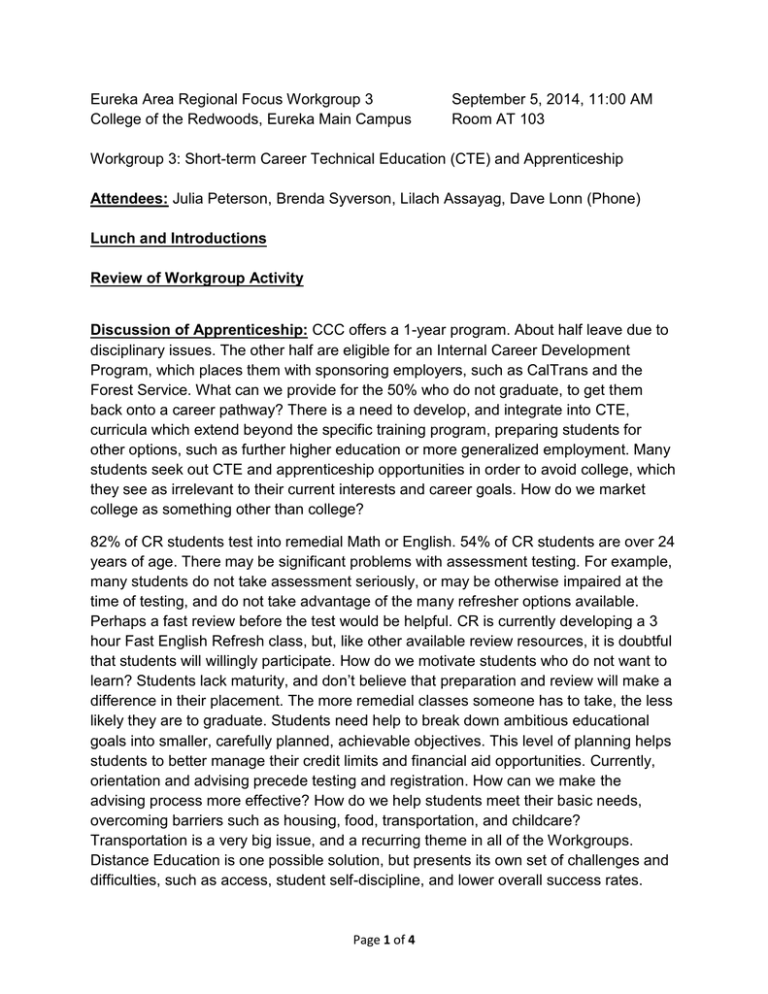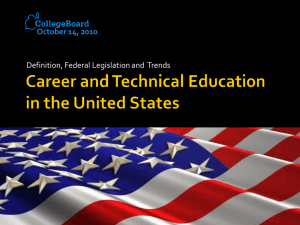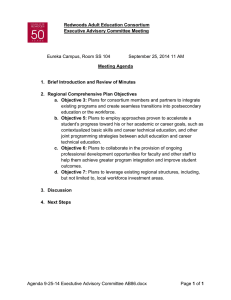Eureka Area Regional Focus Workgroup 3 September 5, 2014, 11:00 AM
advertisement

Eureka Area Regional Focus Workgroup 3 College of the Redwoods, Eureka Main Campus September 5, 2014, 11:00 AM Room AT 103 Workgroup 3: Short-term Career Technical Education (CTE) and Apprenticeship Attendees: Julia Peterson, Brenda Syverson, Lilach Assayag, Dave Lonn (Phone) Lunch and Introductions Review of Workgroup Activity Discussion of Apprenticeship: CCC offers a 1-year program. About half leave due to disciplinary issues. The other half are eligible for an Internal Career Development Program, which places them with sponsoring employers, such as CalTrans and the Forest Service. What can we provide for the 50% who do not graduate, to get them back onto a career pathway? There is a need to develop, and integrate into CTE, curricula which extend beyond the specific training program, preparing students for other options, such as further higher education or more generalized employment. Many students seek out CTE and apprenticeship opportunities in order to avoid college, which they see as irrelevant to their current interests and career goals. How do we market college as something other than college? 82% of CR students test into remedial Math or English. 54% of CR students are over 24 years of age. There may be significant problems with assessment testing. For example, many students do not take assessment seriously, or may be otherwise impaired at the time of testing, and do not take advantage of the many refresher options available. Perhaps a fast review before the test would be helpful. CR is currently developing a 3 hour Fast English Refresh class, but, like other available review resources, it is doubtful that students will willingly participate. How do we motivate students who do not want to learn? Students lack maturity, and don’t believe that preparation and review will make a difference in their placement. The more remedial classes someone has to take, the less likely they are to graduate. Students need help to break down ambitious educational goals into smaller, carefully planned, achievable objectives. This level of planning helps students to better manage their credit limits and financial aid opportunities. Currently, orientation and advising precede testing and registration. How can we make the advising process more effective? How do we help students meet their basic needs, overcoming barriers such as housing, food, transportation, and childcare? Transportation is a very big issue, and a recurring theme in all of the Workgroups. Distance Education is one possible solution, but presents its own set of challenges and difficulties, such as access, student self-discipline, and lower overall success rates. Page 1 of 4 Students who already face many life challenges may be discouraged by the ordinary trials of online information management. Two-way Telepresence is currently being implemented at CR, and will allow for face-to-face interaction between instructor and student, via mobile phone. Northern Humboldt UHSD is currently hosting college credit classes in Advanced Calculus, Psychology, English, Astronomy, and 2 other subjects, for both community members and local high school students from McKinleyville and Arcata. These are not AP classes, but full-credit, fully transferrable college courses. Noncredit classes are more suitable for programs like CCC and DHHS, where students need the flexibility to work around unpredictable schedules and life events without being penalized or stigmatized by the demands of credit classes. Regional Comprehensive Plan Objectives Objective 3: Plans for consortium members and partners to integrate existing programs and create seamless transitions into postsecondary education or the workforce. How do we help people weave existing resources and opportunities together into a comprehensive approach to their journey into postsecondary education and sustainable employment? How do we market outcome-based training without the stigma of higher education? “This is the place where I go to become a tradesperson,” as opposed to “college.” We need to “lead with the job,” and not with the training. The California Department of Education website (http://www.cde.ca.gov/ci/ct/ and http://www.cde.ca.gov/ci/ct/pt/) is a valuable resource for information on clearly defined model career pathways. It seems that, as an adult education consortium, we need to define the most beneficial CTW pathways for potential employees in Humboldt County, and focus on developing those pathways, starting in high school, continuing through graduation, and on to community college or other postsecondary education. Adult education classes can facilitate transitions and help students navigate their pathway over an extended period of time. Equipping students with marketable skills and sustainable employment in the short term increases their overall capacity to pursue further postsecondary education. Defining our CTE pathways will go a long way toward determining what classes we should offer in adult education. The next step in this planning process should support the development and implementation of hands-on, results-oriented CTE curricula, with a focus on appealing to the interests and abilities of kinesthetic and visual-spatial learners. Defining practical short-term goals, such as obtaining professional certification or licensure, can begin the process of motivation to develop an interest in academic subjects for these students. Helping students make the connection between their personal and family economic needs and aspirations and the evolving educational requirements of the workforce is imperative. Creating stackable credentials breaks long-term achievement down into Page 2 of 4 manageable, relevant short-term objectives, providing opportunities for accomplishment, which increase student confidence and motivation. What trades are in demand in this region? The Humboldt County Targets of Opportunity report, the Humboldt County Comprehensive Development Strategy, and information from the Chancellor’s Office (Doing What Matters for Jobs and the Economy) present conflicting information on projected job growth and development in this region. Apparently, different data analyses have led to different conclusions. The Chancellor’s Office report is based on a more regional approach to job growth. We know that a great percentage of graduates of certain programs, such as Nursing, will stay in the area, but some will go to Redding or Willow Creek. The Redwoods region remains geographically unique and isolated, unlike most of California, where daily freeway commuting is relatively common. Targets of Opportunity is very clear and well suited to drawing up the career pathways we are developing. Objective 5: Plans to employ approaches proven to accelerate a student’s progress toward his or her academic or career goals, such as contextualized basic skills and career technical education, and other joint programming strategies between adult education and career technical education. Noncredit Workforce Development classes fit right into this Objective, offering classes in basic skills, soft skills, and hands-on job readiness skills, such as resume writing and interviewing. Workforce Development focuses on how to get a job, and how to keep a job. Integrating basic skills and soft skills into all CTE curricula encourages students to make the connection between education and sustainable employment, and supports a student’s comprehensive educational pathway. Additionally, communication skills, such as how to have a conversation with supervisors or managers, can be contextualized into every aspect of CTE programming. Employer polls consistently indicate that strong communication is universally regarded as essential to employee retention and advancement. From teaching basic personal hygiene, to helping students overcome extreme reactions to criticism, necessary soft skills can be woven into career training. How do we accelerate student progress to maximize resources, and keep students from getting bogged down in remedial education? Tangible, incremental, short-term rewards, such as attractive certificates and resume updates, can hold students’ interest, enhance self-esteem, and increase motivation to keep moving along a pathway. Marketing CTE opportunities to potential students may be complicated by misperceptions and biases. There is a perception that certain words, “career,” for example, are emotionally loaded, imply an impossibly long commitment, and may discourage some learners from pursuing even short-term goals. Page 3 of 4 Objective 6: Plans to collaborate in the provision of ongoing professional development opportunities for faculty and other staff to help them achieve greater program integration and to improve student outcomes. There is a need to train adult education faculty to teach to different styles of learning, and to sensitize them to the special needs of returning and non-traditional students. Ongoing diversity training is essential, perhaps through Humboldt Mediation’s interpersonal skills workshops. Professional development should be presented through collaboration and cooperation among consortium participants, and based on successful model programs. Peer mentoring among faculty is another potentially valuable approach to ongoing professional development and enrichment. CCC stands out as an example of workforce diversity. Shadowing CCC crews in the field could provide “hands on” diversity training within a collaborative framework. Efforts like this might be supported by ongoing diversity and sensitivity seminars, hosted by the various consortium entities on a regular basis. Objective 7: Plans to leverage existing regional structures, including, but not limited to, local workforce investment areas. The consortium region has an abundance of available facilities for CTE and other adult education. Locating classes in proximity to identified adult learner populations reduces travel times and distance, which helps to improve overall enrollment and attendance. Travel distances are a significant barrier in this region, and public transportation is an existing regional structure which must be improved to better serve these populations. Page 4 of 4



